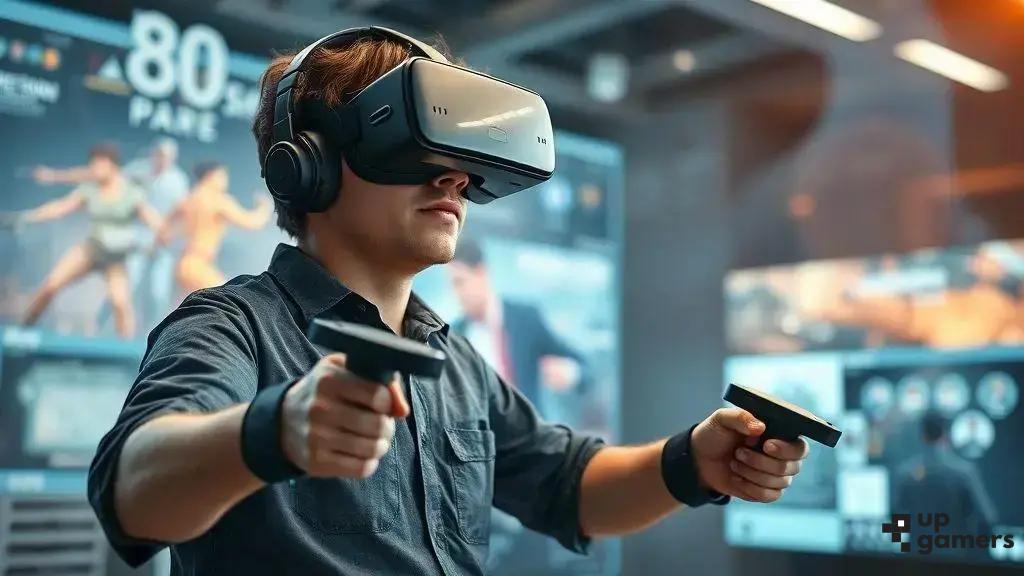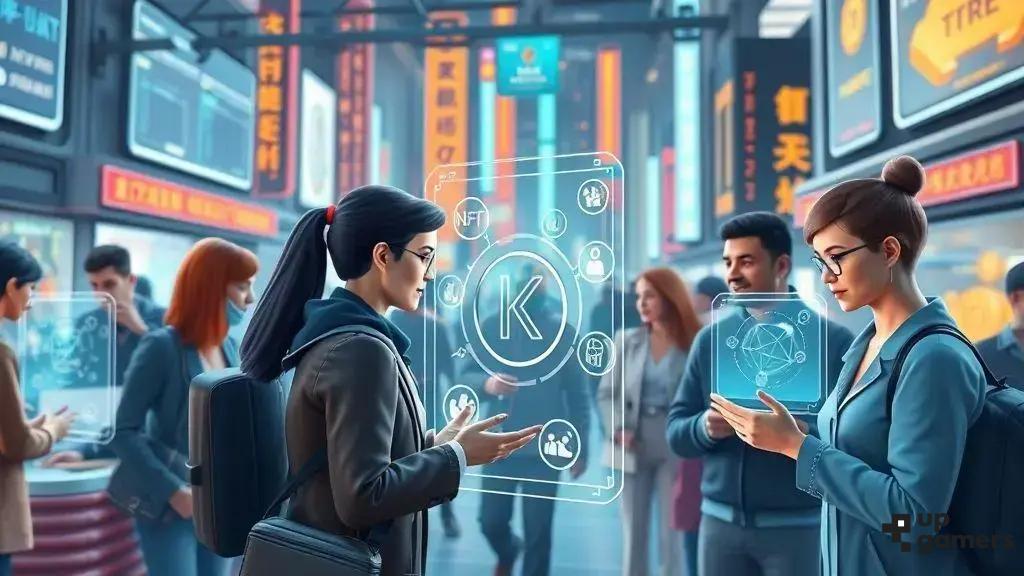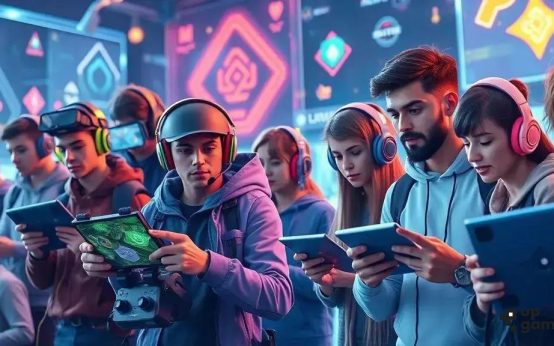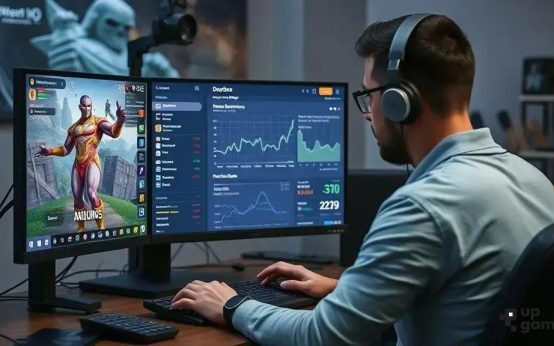Exploring the Metaverse: Gaming Beyond the Screen involves immersive virtual worlds where players connect, own digital assets, and experience games through advanced technologies like VR and AR, creating new social and economic opportunities beyond traditional gameplay.
Exploring the Metaverse: Gaming Beyond the Screen opens a door to a new world where gaming isn’t just on your device but all around you. Ever wondered how this shifts your experience or what it means for the future of play? Let’s dive in and find out together.
what is the metaverse and why it matters for gaming
The metaverse is a virtual shared space that merges physical and digital realities, allowing players to interact through avatars in immersive environments. It goes beyond traditional gaming by creating a persistent world where actions and experiences continue even after logging off. This new digital frontier blends gaming with social connections, digital economies, and real-time collaboration.
Unlike conventional games, the metaverse isn’t limited to a single game or platform. It’s a vast network of interconnected virtual spaces where players can explore, create, and socialize freely. This flexibility makes gaming more engaging and personal, as users shape their own experiences and communities.
Understanding why the metaverse matters for gaming requires recognizing its potential to revolutionize how we play. It offers immersive, interactive stories and new ways for players to connect, trade virtual assets, and participate in shared events. It also opens doors to creative expression and economic opportunities that were impossible in traditional games.
how immersive technologies change gameplay

Immersive technologies like virtual reality (VR), augmented reality (AR), and mixed reality (MR) are transforming gameplay by creating deeply engaging environments. These technologies allow players to experience games in 3D spaces where they can move, interact, and feel part of the virtual world. Virtual reality headsets place players inside the game, making actions more natural and intuitive.
Augmented reality enhances the real world by overlaying digital objects and information, blending gaming with the player’s physical surroundings. This can turn everyday places into game arenas, adding excitement and unpredictability. Mixed reality goes further by allowing digital and real objects to coexist and interact seamlessly.
Enhanced Player Interaction
With immersive tech, players can use gestures, voice commands, and even eye movements to control gameplay. This level of interaction creates a more personalized and responsive experience. Players are not just pressing buttons; they become active participants in a living virtual world.
Impact on Game Design
Game developers are now crafting experiences that prioritize immersion and realism. Levels are designed for exploration and physical activity, and narratives become more dynamic, changing based on players’ actions in real time. This shift challenges traditional gameplay and opens new creative possibilities.
The rise of immersive technologies is also pushing the boundaries of social gaming. Players can meet, collaborate, or compete in virtual spaces, making gaming a shared and interactive experience beyond simple screen-based play.
social connections and communities inside the metaverse
Social connections in the metaverse go beyond typical online interactions by creating fully immersive environments where people can meet, socialize, and collaborate using avatars. This virtual presence allows for more natural and engaging communication, including gestures, voice chats, and shared activities.
Communities inside the metaverse can form around common interests, games, or virtual events. These groups foster a strong sense of belonging and support, much like real-world social circles. Players can attend concerts, participate in group challenges, or simply hang out in custom-designed spaces.
The rise of virtual events and gatherings
With the ability to host large-scale virtual events, the metaverse is redefining social experiences. Conferences, concerts, and meetups happen within these worlds, attracting global audiences and enabling real-time interaction. This opens new doors for creativity and participation.
Building identity and expression
Avatars provide a canvas for self-expression, allowing users to customize their appearance and persona. This personalization helps people feel more connected and authentic within their communities. Identity in the metaverse becomes a blend of creativity and social interaction.
These social dynamics are a key reason why the metaverse is reshaping gaming into a shared, living experience. It’s no longer about playing alone but being part of vibrant communities where stories and friendships grow.
economic opportunities and virtual ownership in games

The metaverse creates new economic opportunities by allowing players to buy, sell, and trade virtual assets with real value. This includes digital land, clothing for avatars, game items, and even virtual businesses. These assets often use blockchain technology to guarantee ownership and scarcity.
Virtual ownership and blockchain
Blockchain provides a secure way to prove who owns what in the metaverse. This means players can truly own their digital items and transfer them between games or platforms. This decentralization adds real financial value to virtual goods and empowers users economically.
Players can also earn money by creating content, hosting events, or offering services like virtual design or coaching. Games become platforms for entrepreneurship and creativity, opening new career paths within virtual worlds.
Marketplaces and trading
Specialized marketplaces allow trading of non-fungible tokens (NFTs), which represent unique digital assets. These platforms enable players to invest in and profit from their virtual possessions, often leading to thriving economies inside games.
The growing acceptance of virtual economies shows how gaming is evolving into a significant digital marketplace. This shift builds bridges between entertainment and real-world financial systems, making the metaverse a promising space for economic innovation.
the challenges and future of metaverse gaming
Despite its exciting potential, metaverse gaming faces several important challenges that could impact its growth. Technical issues like high costs of hardware, slow internet speeds, and the complexity of creating seamless virtual worlds limit broader adoption. Not everyone has access to the required technology to fully enjoy these experiences.
Privacy and security concerns
As players spend more time in virtual spaces, protecting personal data and ensuring secure transactions become critical. The metaverse raises questions about user safety, data ownership, and potential abuses like hacking or harassment. Addressing these issues is essential for building trust.
Regulatory and ethical challenges
With economies and social interactions happening online, governments and organizations face the task of creating rules for this new space. Issues like virtual property rights, fair play, and content moderation need clear guidelines. Developing ethical standards will shape the future experience.
The future of metaverse gaming depends on solving these problems alongside continuous innovation. Improvements in technology, wider access, and stronger safety measures can help unlock the full potential of immersive, connected play. The evolving landscape promises new ways to entertain, connect, and create in digital worlds.
Looking ahead: the evolving world of metaverse gaming
The metaverse is reshaping how we play, connect, and even earn in virtual worlds. While challenges like technology limits and privacy concerns remain, the potential for immersive experiences is huge.
As access improves and rules get clearer, more people will join these digital spaces and enjoy new ways to interact and create. The future of metaverse gaming promises exciting adventures and opportunities for everyone.
Staying informed and open to these changes can help players and developers make the most of this growing virtual frontier.
FAQ – Exploring the Metaverse: Gaming Beyond the Screen
What is the metaverse in gaming?
The metaverse is a virtual shared space that merges physical and digital realities, letting players interact through avatars in immersive environments beyond traditional games.
How do immersive technologies change gameplay?
Technologies like VR and AR create 3D spaces where players move and interact naturally, making games more engaging and personal.
What social opportunities exist in the metaverse?
Players can meet, socialize, attend virtual events, and build communities with avatars, creating strong connections and shared experiences.
Can I own virtual assets in the metaverse?
Yes, players can buy, sell, and trade digital items using blockchain technology, giving true ownership and economic value to virtual goods.
What challenges does metaverse gaming face?
Challenges include technical limits, privacy and security concerns, and the need for clear regulations to protect users and ensure fair play.
What is the future outlook for metaverse gaming?
With ongoing innovation and better access, the metaverse will offer more immersive, social, and economic experiences that change how we play and connect.




